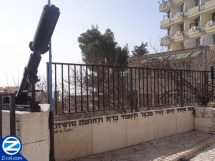Davidka of Safed
 | |
| Hebrew: | |
|---|---|
| לדודקה | |
| Pronunciation: | |
| Dav-eed’ka | |
| Translation | |
| Little David | |
| Description: | |
| Artillery equipment used in the defense of Safed during the 1948 Battle of Tzfat. |
The story of the Davidka encapsulates the story of Tzfat's struggles during the War of Independence.
Contents |
[edit] Historical Overview
In 1948 the British, who had been ruling Palestine under the British Mandate, departed after the United Nations voted to grant independence to the Jewish State under a partition plan. One of the Jewish areas that was under relentless attack was the Jewish Quarter of Tzfat. Both Arab and Jewish commanders had declared that the city was their “Capitol of the Galilee” and both sides placed whatever resources that they could to capture the city. The Arabs and Jews had been fighting for control of the city for several months even before the British April 1948 departure.
As hundreds of Arab soldiers from Iraq and Lebanon arrived to bolster the Arab forces, the “Haganah” -- Jewish Defense Forces -- began looking for alternate ways to gain the upper hand. The arrival of the Davidka provided such an opportunity.
[edit] Davidka
The “Davidka” -- Little David -- was built at the Mikveh Israel agricultural school near Tel Aviv by David Leibovitch. The name, “Davidka” honored the weapon’s designer but also brought to mind the Biblical battle between Little David and Goliath. The artillery piece was designed to create fear as its whistles and shrieks produced a frightening noise as it flew through the air and made a huge noise upon impact. The Davidka was an important psychological weapon though the inaccuracy of the projectile made it fairly useless for combat purposes.
[edit] Davidka in Tzfat
Leibovitch built six Davidkas and they were distributed to the three Haganah battalions -- Yiftach in the north, Harel in Jerusalem and HaNegev in the South. The commander of the Yiftach battalion, Yigal Alon (later a noted archaeologist and member of Kenesset) decided to deploy one of the Davidkas in Tzfat. The Haganah began to fire the Davidka into the Arab Quarter in early May 1948.
[edit] Damage
The Davidka’s actual projectile did little damage but the psychological effect was profound. The weapon’s tremendous noise caused the Arab population and fighters to panic.
[edit] Rumor
The explosions, along with rumors, convinced the Arab population of Tzfat that the Davidka was, in fact, the atom bomb. Some people say that the Haganah commander spread the rumor among Arab spies who were working for the Haganah while others claim that the rumor originated among Jewish residents who passed the information on to Arabs with whom they were acquainted. At any rate the Arabs of Tzfat believed that the Davidka’s earth-shattering blasts were the blasts of a small atom bomb (the early May rains that occurred during this period further encourage these rumors since the belief was that it would rain after an atom blast). Overnight, the entire Arab population fled from Tzfat.
[edit] Miracle
Many people took the story of the Davidka as a open miracle from G-D, since it defies nature how such a little piece of artillery could bring about such a victory.
[edit] Liberation of Tzfat
Once the Arab population fled, the Arab soldiers guarding the three strongholds -- the Police Station, the Shalva Building at the entrance to the city and the Citadel lost their will to fight. The Haganah fighters were able to capture Beit Shalva and the Citadel on May 10th and almost immediately the Iraqi soldiers who had been guarding the Police Station slipped out under the cover of night.
| ||||||||||||||
| |||||||||||||||||
| |||||||||||||||||

